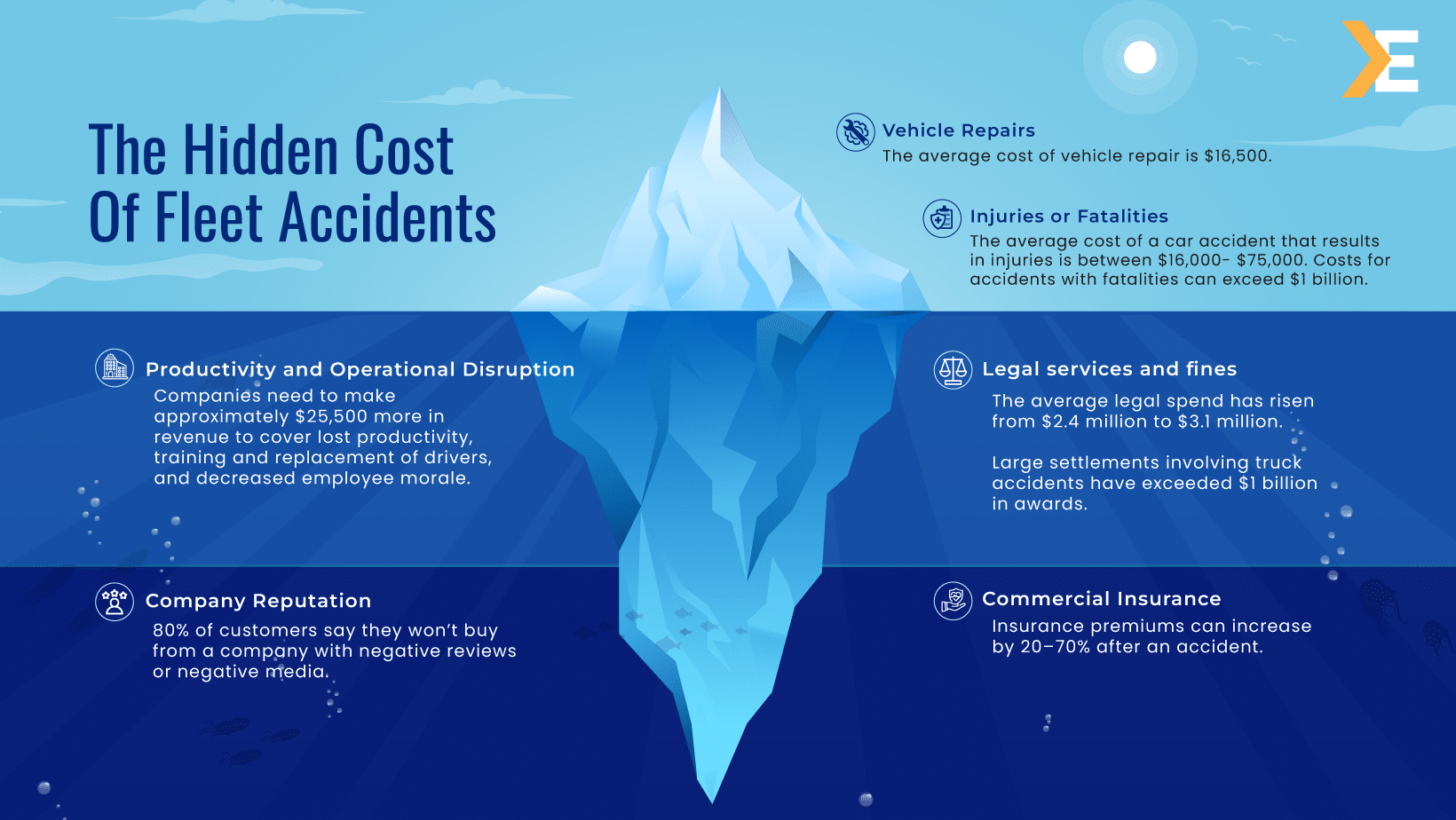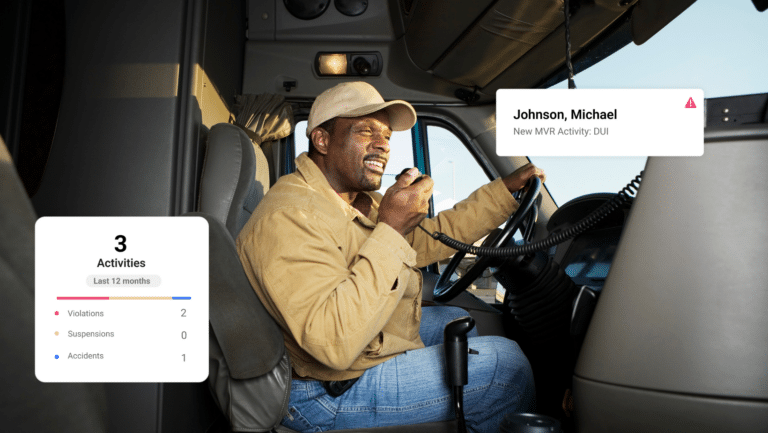4 Traffic Violations Contributing to Fleet Accidents

With the rise in nuclear verdicts, mitigating risks and preventing fleet accidents and incidents from happening in the first place is extremely important. According to Dough Marcello, attorney of Saxton & Stump, roughly 95% of all fleet accident cases end in settlement.
Identifying risky driving trends and how violations can impact your fleet is crucial. Let’s take a deep dive into critical violations that are part of most fleet accidents.
Top violations that could lead to fleet accidents
1. Speeding
For more than two decades, speeding has been involved in approximately one-third of all motor vehicle fatalities. In 2021, speeding was a contributing factor in 29% of all traffic fatalities.
Speeding reduces a driver’s ability to assess their surroundings accurately and anticipate potential hazards. Higher speeds make it more difficult for drivers to maintain control of their vehicles. Speeding requires a longer distance to bring a vehicle to a stop. For every 10 mph of increased speed, the risk of dying in a crash doubles. Increasing driving speed from 60 mph to 80 mph increases the risk of a fatal crash by 4 times.
2. Driving under the influence (DUI)
According to the National Highway Traffic Safety Administration (NHTSA), 32% of traffic crash fatalities involve drunk drivers.
Alcohol and drugs impair drivers’ ability to think clearly and make sound decisions while driving. This often results in engaging in risky behaviors such as speeding, tailgating, and attempting dangerous maneuvers on the road. These actions significantly increase the likelihood of accidents, posing serious risks to others on the road.

A 21-year-old semi-truck driver was charged with DUI manslaughter after causing a crash that killed a woman. Deputies found four empty Modelo beer cans near the crash scene. Read more: Nuclear Verdicts: How to reduce exposure?
3. Distracted driving
Distraction has been an issue for drivers as long as we’ve operated motor vehicles. The fast pace of life today encourages people to multi-task, even while driving.
When drivers take their eyes off the road to look at their phones, GPS devices, or even objects (or people) inside the vehicle, they lose awareness of their surroundings. Even a split-second distraction can lead to a collision. A study by the AAA Foundation for Traffic Safety found that taking your eyes off the road for just two seconds doubles the chances of being involved in a crash. Read more: How to spot fleet distracted driving trend
4. Reckless driving
Aggressive driving is a factor in 54% of all fatal motor vehicle crashes, according to the AAA Foundation for Traffic Safety.
Reckless driving encompasses various dangerous behaviors such as speeding, aggressive driving, tailgating, running red lights or stop signs, and weaving in and out of traffic.
After running a red light, a service truck struck a Waukesha school bus with 34 students on board. Eight students suffered minor injuries from the crash, with one student being transported to the hospital for further medical evaluation.
Research in traffic psychology has shown that there’s a correlation between past violations and future driving behavior (a.k.a “habitual offender syndrome”). Drivers who have violated traffic laws in the past are more likely to do so again in the future, especially if they haven’t faced significant consequences or if they haven’t undergone any interventions to address their driving behavior.
The true cost of fleet accidents extends far beyond the immediate incident itself. While the direct impact of fleet accidents includes vehicle repair costs and medical expenses, the ramifications can ripple out in various ways. According to the Occupational Safety and Health Administration (OSHA), fleet accidents cost employers around $60 billion annually in medical, legal, insurance, loss of productivity, and more.

Click the graphic to enlarge.
A manager’s worst nightmare can stem from just one oversight in a fleet safety program. Take, for instance, a scenario where a company diligently conducts annual checks, yet during an accident, it’s discovered that the driver was operating with a suspended license.
If an accident occurs involving a vehicle in the fleet, and it’s found that the organization neglected safety protocols or failed to address known risks, the company could face significant legal liabilities.
In accident cases resulting in settlements, plaintiff’s attorneys tend to not only focus on an accident but also dig into a carrier’s safety records. “When it comes to truck accidents, various factors are considered to establish liability. This includes investigating the driver’s actions. Additionally, factors such as driver fatigue, improper maintenance of the truck, and violations of federal trucking regulations may also contribute to liability. It’s essential to thoroughly investigate the circumstances surrounding the accident to identify all parties responsible for the tragedy,” said Michael Haggard, truck accident attorney.
Identifying risky behavior and taking action
Ensuring fleet safety isn’t just about ticking boxes—it’s a commitment to proactive risk management and employee well-being.
At its core, this responsibility means keeping a vigilant eye on your drivers’ records and behavior. Regular reviews of Motor Vehicle Records (MVRs) are essential. Many employers take it a step further by enrolling their employees in MVR monitoring, which provides near real-time alerts about any changes, such as new violations or license suspensions.
But having this information is just the beginning. The real test lies in what you do with it. Identifying an employee with a history of risky driving behavior is one thing; taking decisive action to address it is another. This could involve tailored training programs to improve driving skills, enhance awareness of safety protocols and company vehicle policy, or even implement disciplinary measures when necessary.
By actively addressing risky driving trends, employers fulfill their legal obligation and prioritize the safety of their employees, other road users, and the company’s reputation.
Need help mitigating your company’s driver risk? Explore our comprehensive MVR Monitoring solution, offering near real-time alerts on new negative MVR changes and access to over 100+ lessons for personalized training.
*We are not lawyers. Consult with your legal counsel to ensure your processes and procedures meet/ or exceed safety standards and compliance regulations. Please read our legal disclaimer.






